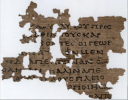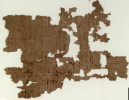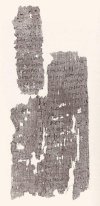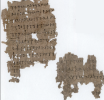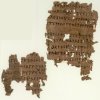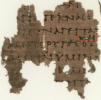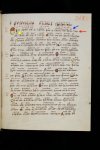The earliest known manuscript (or manuscript fragment in this case) is P 52. Some have suggested a date as early as ca. 125. However most scholars opt for a mid 2nd century date (ca. 150). Since there is writing on both sides, P 52 was not part of a scroll but a codex.
John 18:31-33 (recto)

ΟΙ ΙΟΥΔΑΙΟΙ ΗΜΕΙΝ ΟΥΚ ΕΞΕΣΤΙΝ ΑΠΟΚΤΕΙΝΑΙ
ΟΥΔΕΝΑ ΙΝΑ Ο ΛΟΓΟΣ ΤΟΥ ΙΗΣΟΥ ΠΛΗΡΩΘΗ ΟΝ ΕΙ
ΠΕΝ ΣΗΜΑΙΝΩΝ ΠΟΙΩ ΘΑΝΑΤΩ ΗΜΕΛΛΕΝ ΑΠΟ
ΘΝΗΣΚΕΙΝ ΙΣΗΛΘΕΝ ΟΥΝ ΠΑΛΙΝ ΕΙΣ ΤΟ ΠΡΑΙΤΩ
ΡΙΟΝ Ο ΠΙΛΑΤΟΣ ΚΑΙ ΕΦΩΝΗΣΕΝ ΤΟΝ ΙΗΣΟΥΝ
ΚΑΙ ΕΙΠΕΝ ΑΥΤΩ ΣΥ ΕΙ O ΒΑΣΙΛΕΥΣ ΤΩΝ ΙΟΥ
ΔΑΙΩN
John 18:37-38 (verso)
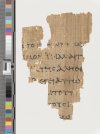
ΒΑΣΙΛΕΥΣ ΕΙΜΙ ΕΓΩ ΕΙΣ TOΥΤΟ ΓΕΓΕΝΝΗΜΑΙ
ΚΑΙ ΕΛΗΛΥΘΑ ΕΙΣ ΤΟΝ ΚΟΣΜΟΝ ΙΝΑ ΜΑΡΤΥ
ΡΗΣΩ ΤΗ ΑΛΗΘΕΙΑ ΠΑΣ Ο ΩΝ ΕΚ ΤΗΣ ΑΛΗΘΕI
ΑΣ ΑΚΟΥΕΙ ΜΟΥ ΤΗΣ ΦΩΝΗΣ ΛΕΓΕΙ ΑΥΤΩ
Ο ΠΙΛΑΤΟΣ ΤΙ ΕΣΤΙΝ ΑΛΗΘΕΙΑ ΚΑΙ ΤΟΥΤΟ
ΕΙΠΩΝ ΠΑΛΙΝ ΕΞΗΛΘΕΝ ΠΡΟΣ ΤΟΥΣ ΙΟΥ
ΔΑΙΟΥΣ ΚΑΙ ΛΕΓΕΙ ΑΥΤΟΙΣ ΕΓΩ ΟΥΔΕΜΙΑΝ
There are no complete sentences\verses in this fragment. The text has to be reconstructed. The letters in black are the visible letters on the fragment. The letters in red are the missing part of the text.
Every few days (2 or 3) I will post another manuscript from the 2nd century.
Note - papyrus evidence is given the letter designation P and a number.
Note - there are no N.T. manuscripts which date back to the 1st century, as far as anybody knows.
John 18:31-33 (recto)

ΟΙ ΙΟΥΔΑΙΟΙ ΗΜΕΙΝ ΟΥΚ ΕΞΕΣΤΙΝ ΑΠΟΚΤΕΙΝΑΙ
ΟΥΔΕΝΑ ΙΝΑ Ο ΛΟΓΟΣ ΤΟΥ ΙΗΣΟΥ ΠΛΗΡΩΘΗ ΟΝ ΕΙ
ΠΕΝ ΣΗΜΑΙΝΩΝ ΠΟΙΩ ΘΑΝΑΤΩ ΗΜΕΛΛΕΝ ΑΠΟ
ΘΝΗΣΚΕΙΝ ΙΣΗΛΘΕΝ ΟΥΝ ΠΑΛΙΝ ΕΙΣ ΤΟ ΠΡΑΙΤΩ
ΡΙΟΝ Ο ΠΙΛΑΤΟΣ ΚΑΙ ΕΦΩΝΗΣΕΝ ΤΟΝ ΙΗΣΟΥΝ
ΚΑΙ ΕΙΠΕΝ ΑΥΤΩ ΣΥ ΕΙ O ΒΑΣΙΛΕΥΣ ΤΩΝ ΙΟΥ
ΔΑΙΩN
John 18:37-38 (verso)

ΒΑΣΙΛΕΥΣ ΕΙΜΙ ΕΓΩ ΕΙΣ TOΥΤΟ ΓΕΓΕΝΝΗΜΑΙ
ΚΑΙ ΕΛΗΛΥΘΑ ΕΙΣ ΤΟΝ ΚΟΣΜΟΝ ΙΝΑ ΜΑΡΤΥ
ΡΗΣΩ ΤΗ ΑΛΗΘΕΙΑ ΠΑΣ Ο ΩΝ ΕΚ ΤΗΣ ΑΛΗΘΕI
ΑΣ ΑΚΟΥΕΙ ΜΟΥ ΤΗΣ ΦΩΝΗΣ ΛΕΓΕΙ ΑΥΤΩ
Ο ΠΙΛΑΤΟΣ ΤΙ ΕΣΤΙΝ ΑΛΗΘΕΙΑ ΚΑΙ ΤΟΥΤΟ
ΕΙΠΩΝ ΠΑΛΙΝ ΕΞΗΛΘΕΝ ΠΡΟΣ ΤΟΥΣ ΙΟΥ
ΔΑΙΟΥΣ ΚΑΙ ΛΕΓΕΙ ΑΥΤΟΙΣ ΕΓΩ ΟΥΔΕΜΙΑΝ
There are no complete sentences\verses in this fragment. The text has to be reconstructed. The letters in black are the visible letters on the fragment. The letters in red are the missing part of the text.
Every few days (2 or 3) I will post another manuscript from the 2nd century.
Note - papyrus evidence is given the letter designation P and a number.
Note - there are no N.T. manuscripts which date back to the 1st century, as far as anybody knows.

